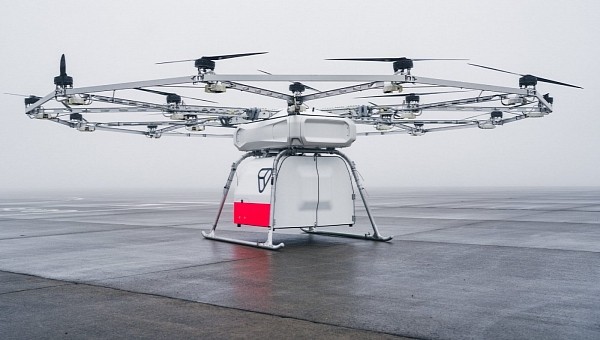Unlike other eVTOL (electric vertical take-off and landing) developers that come up with a single, versatile model for multiple roles, Volocopter launched both an air taxi and a cargo drone and has been testing them for some time now. Most recently, the VoloDrone was the one in the spotlight, after successfully completing a two-week test flight campaign, part of a larger European project.
The heavy-lift cargo carrier got to show what it can do during an extensive test campaign at the DLR (German Aerospace Center) National Experimental Test Center for Unmanned Aircraft in Germany. What’s fascinating is that although the tests were physically carried out at the Magdeburg-Cochstedt Airport, the digital airspaces that were actually simulated within this space were Frankfurt Airport and London airports.
Each case study represented a different exercise for air traffic management. In the German one, the cargo drone simulated flying between Messe Frankfurt and the Frankfurt Airport, and then diverting that route when the VoloIQ system got the signal for a priority landing of an EMS (Emergency Medical Services) aircraft.
In the UK case, the VoloDrone had to show that it can decrease its flight speed when reaching the busy airspace above London airports. Again, the conditions of this airspace were mapped out to fit the physical space at Cochstedt, Germany and digitally simulated.
In both cases, the VoloIQ technology had to manage the cargo drone’s flight path and speed, in accordance with other air vehicles and the overall air traffic.
The campaign was part of the European-funded CORUS-XUAM project for integrating unmanned traffic management (UTM) within digital air traffic management (ATM). In other words, future autonomous air taxis and cargo drones must be able to share the lower airspace with conventional aircraft, in a safe and effective way.
The VoloDrone also revealed several upgrades, including a fiberglass housing, an overhauled fuselage, and scalable rotor beams made of aluminum. The VoloDrone claims an unprecedented cargo capacity of 200 kg (441 lbs) and a 40 km (24.8 miles) range.
Each case study represented a different exercise for air traffic management. In the German one, the cargo drone simulated flying between Messe Frankfurt and the Frankfurt Airport, and then diverting that route when the VoloIQ system got the signal for a priority landing of an EMS (Emergency Medical Services) aircraft.
In the UK case, the VoloDrone had to show that it can decrease its flight speed when reaching the busy airspace above London airports. Again, the conditions of this airspace were mapped out to fit the physical space at Cochstedt, Germany and digitally simulated.
In both cases, the VoloIQ technology had to manage the cargo drone’s flight path and speed, in accordance with other air vehicles and the overall air traffic.
The campaign was part of the European-funded CORUS-XUAM project for integrating unmanned traffic management (UTM) within digital air traffic management (ATM). In other words, future autonomous air taxis and cargo drones must be able to share the lower airspace with conventional aircraft, in a safe and effective way.
The VoloDrone also revealed several upgrades, including a fiberglass housing, an overhauled fuselage, and scalable rotor beams made of aluminum. The VoloDrone claims an unprecedented cargo capacity of 200 kg (441 lbs) and a 40 km (24.8 miles) range.








